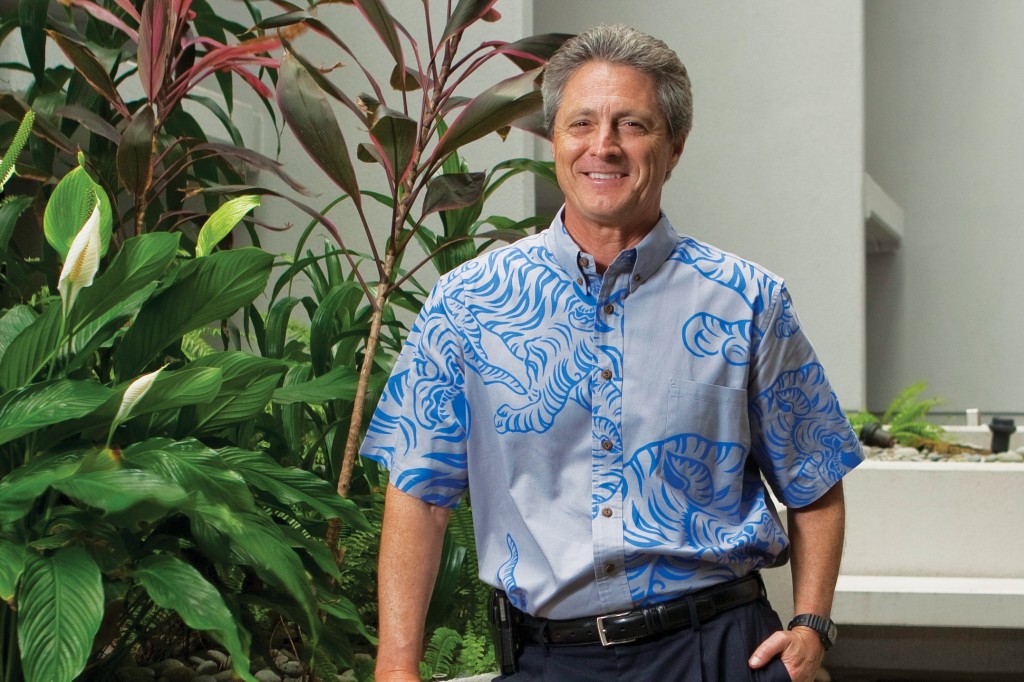Talk Story with Tim Johns of HMSA

Tim Johns has had an eclectic career. He recently became a senior VP at HMSA and was co-chair of the APEC Hawaii Host Committee. Previously, he served as CEO ofBishop Museum, COO of the Damon Estate, VP of Amfac, chairman of the state Department of Land and Natural Resourcesand a director for the Nature Conservancy. We spoke with him about the value of this broad experience.
In your career, you’ve moved back and forth between the public and private sectors. Are there advantages to that career path?
For me, it’s actually been a three-way move, because it’s been public sector, nonprofit world and then private sector. In some places, there’s a revolving door between the private sector and the public sector; but I also think it’s important to understand the nonprofit world.
As far as the benefits, I think it’s better for people to understand how the different parts of the community work. I know a lot of really smart, successful people in the private sector who really don’t understand how the public sector works – what the motivations are, what the incentives are. And, unless you work in that field, it’s hard to understand that. I think the exposure to how all these sectors work makes you not only a better asset to your current employer, it makes you a better citizen as well.
You don’t see many people taking that path in Hawaii.
Maybe in some other communities it’s done more often. In places like Washington, D.C., people do their public service, then they jump into the private sector and maybe come back to public service in the next administration. But I’m not sure that we do it as much in Hawaii. People kind of stay in their lane once they get in their lane. It might just be a generational thing: People are a little bit more insecure about their future, so they’re not willing to put their careers at risk by jumping off into another area. … Early on in my career, though, I had some good mentors – people like Herb Cornuelle and Walter Dods – who told me it was important to understand the larger community outside your specific job. I tell young people the same thing: Get out, get involved, sit on nonprofit boards, think about going into the public sector for a while.
Intellectually, that kind of cross-pollination seems like it’s a win/win proposition. But are there costs?
Oh, yes. You’re asking people to go outside their comfort zone, outside their own image of themselves. So you might see yourself as a Bishop Street, corporate guy, climbing those ladders, whatever they are. To go jump into the public sector or nonprofit sector does cause people to take some pause. If it’s a very competitive world they’re in, jumping off that treadmill to go do something else could cause people to feel like they’ve fallen behind their colleagues and peers. Even if you’re good at what you do in the private sector, there would be a learning curve in either the public sector or the nonprofit world. No matter who you are, that could put your reputation for competency at risk.
Are the challenges in one sector easier than in the others?
I’m not sure going one way is easier than another; they’re just different. So, I’m not sure if you’re successful in the public sector that it means it’s easier to shift over to the private sector or vice versa. I don’t know. People think the private sector is more challenging, somehow, than being in the nonprofit world or the public sector, but, in a lot of ways, that’s not true. Some things are easier done in the private sector, and some things are easier done in the public sector.
Do you prefer one sector over the others?
No. I like public-policy issues, so I like looking at problems in our community and how they could be solved or improved. … And to really affect major change, you can’t ignore the public sector. But working in the nonprofit world is also wonderful. It’s rare that you get to work in a place with an altruistic mission where everybody, for the most part, is driven by that mission. You don’t feel that as much in the other sectors. Then, in the private sector, there’s a lot more clarity at times about what the constituencies are and what the rules are. People are somewhat easier to motivate because the mission and vision and all that are pretty clear. When you’re working in the public sector you have so many different, varied constituencies that sometimes you’ve got conflicting missions and you have to balance that. And in the nonprofit world, sometimes it’s harder to impose private-sector discipline onto an organization because people are attracted by the altruistic mission and not necessarily by the efficacy of operations.
Then how do you decide which path to take?
For me, it was always more important to do interesting work than whether it was something I knew how to do already. It was more interesting to me to learn about things and face those kinds of intellectual challenges. Maybe I’m not like everybody else, though. I might have adult ADHD. Some people tell me, “You’ve had an interesting career.” Other people say, “The bugger can’t keep a job.” It’s not like I have to flit from place to place, but I do like being in a place that poses challenges. I do try to make a difference every place I’m at before I move on, though.
You might be running out of places.
No, I’m running out of time. But I think I’ve found a home here at HMSA. This is a job that’s going to be constantly challenging. (The medical system) is a conundrum that’s got to be unwound. We’ve built this system over many, many years, and to improve it is going to take many, many years.






